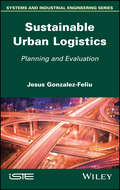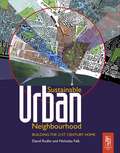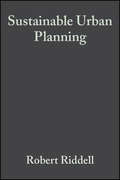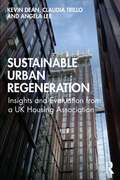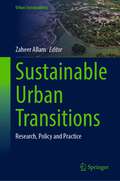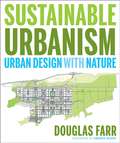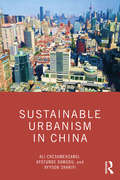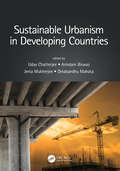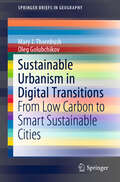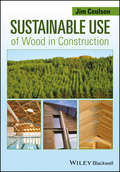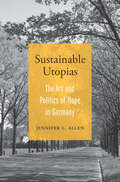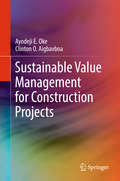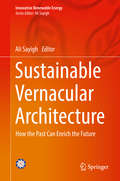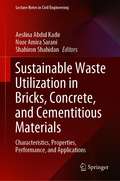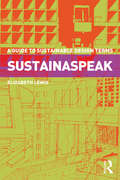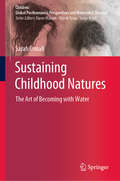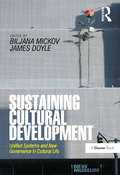- Table View
- List View
Sustainable Urban Logistics: Planning and Evaluation (EcoProduction #3)
by Jesus Gonzalez-FeliuUrban logistics has been a subject of interest to researchers and practitioners for more than 20 years in France and Europe, and more than 40 in the United States. Nevertheless, the subject remains difficult to address by a lack of unification in the definitions and proposed methods but also by what makes its great richness: the diversity of actors and the pluridisciplinarity of the methods and techniques available.This book, which synthesizes more than 10 years of personal research on the subject, but also experience within different teams and projects, intends to bring a unified vision (and more and more followed at the international level) on logistics planning Urban development. It begins with an overview of research in urban logistics and then describes and defines the main components: flows, actors, infrastructures, management components, technologies, regulations and financing actions. A unified vision of these elements as well as the definition of sustainable urban logistics is proposed.Then, the book presents the basics of planning and managing sustainable urban logistics. First, the basics of the before-after analysis are introduced, not only for the experiments but also for the simulation of scenarios. To carry out this type of analysis, two main groups of methods are needed: methods for estimating flows and methods for calculating evaluation indicators. The book presents the main global standards and dominant models for the estimation of the urban freight transport demand, i.e. of freight transport needs in urban areas. Then it presents the methods for estimating and simulating transport and distribution schemes (i.e. transport supply) as well as a proposal for integrated supply-demand modeling. All these methods are presented for immediate application to practitioners, accompanied by summary tables and parameters necessary for their implementation.As far as evaluation is concerned, the book presents a framework for the choice of sustainable indicators and scorecards. Second, the main methods for economic, environmental, social and accessibility assessment are presented. They are accompanied by tables and figures necessary for their implementation. Finally, the main applications of the proposed methods are introduced. The book is meant to be a practical guide to applying the main methods from scientific research to a practical context, and presents examples of quantified and explained application. It is thus the first book that summarizes and presents the main unified methods to help the different decision-makers to implement them in their actions of planning and management of the urban logistics and the transport of goods in town.
Sustainable Urban Logistics: Planning and Evaluation
by Jesus Gonzalez-FeliuUrban logistics has been a subject of interest to researchers and practitioners for more than 20 years in France and Europe, and more than 40 in the United States. Nevertheless, the subject remains difficult to address by a lack of unification in the definitions and proposed methods but also by what makes its great richness: the diversity of actors and the pluridisciplinarity of the methods and techniques available.This book, which synthesizes more than 10 years of personal research on the subject, but also experience within different teams and projects, intends to bring a unified vision (and more and more followed at the international level) on logistics planning Urban development. It begins with an overview of research in urban logistics and then describes and defines the main components: flows, actors, infrastructures, management components, technologies, regulations and financing actions. A unified vision of these elements as well as the definition of sustainable urban logistics is proposed.Then, the book presents the basics of planning and managing sustainable urban logistics. First, the basics of the before-after analysis are introduced, not only for the experiments but also for the simulation of scenarios. To carry out this type of analysis, two main groups of methods are needed: methods for estimating flows and methods for calculating evaluation indicators. The book presents the main global standards and dominant models for the estimation of the urban freight transport demand, i.e. of freight transport needs in urban areas. Then it presents the methods for estimating and simulating transport and distribution schemes (i.e. transport supply) as well as a proposal for integrated supply-demand modeling. All these methods are presented for immediate application to practitioners, accompanied by summary tables and parameters necessary for their implementation.As far as evaluation is concerned, the book presents a framework for the choice of sustainable indicators and scorecards. Second, the main methods for economic, environmental, social and accessibility assessment are presented. They are accompanied by tables and figures necessary for their implementation. Finally, the main applications of the proposed methods are introduced. The book is meant to be a practical guide to applying the main methods from scientific research to a practical context, and presents examples of quantified and explained application. It is thus the first book that summarizes and presents the main unified methods to help the different decision-makers to implement them in their actions of planning and management of the urban logistics and the transport of goods in town.
Sustainable Urban Neighbourhood
by David Rudlin Nicholas FalkThis successful title, previously known as 'Building the 21st Century Home' and now in its second edition, explores and explains the trends and issues that underlie the renaissance of UK towns and cities and describes the sustainable urban neighbourhood as a model for rebuilding urban areas.The book reviews the way that planning policies, architectural trends and economic forces have undermined the viability of urban areas in Britain since the Industrial Revolution. Now that much post-war planning philosophy is being discredited we are left with few urban models other than garden city inspired suburbia. Are these appropriate in the 21st century given environmental concerns, demographic change, social and economic pressures? The authors suggest that these trends point to a very different urban future.The authors argue that we must reform our towns and cities so that they become attractive, humane places where people will choose to live. The Sustainable Urban Neighbourhood is a model for such reform and the book describes what this would look like and how it might be brought about.
Sustainable Urban Neighbourhood: The Sustainable Urban Neighbourhood
by David Rudlin Nicholas FalkThis successful title, previously known as 'Building the 21st Century Home' and now in its second edition, explores and explains the trends and issues that underlie the renaissance of UK towns and cities and describes the sustainable urban neighbourhood as a model for rebuilding urban areas.The book reviews the way that planning policies, architectural trends and economic forces have undermined the viability of urban areas in Britain since the Industrial Revolution. Now that much post-war planning philosophy is being discredited we are left with few urban models other than garden city inspired suburbia. Are these appropriate in the 21st century given environmental concerns, demographic change, social and economic pressures? The authors suggest that these trends point to a very different urban future.The authors argue that we must reform our towns and cities so that they become attractive, humane places where people will choose to live. The Sustainable Urban Neighbourhood is a model for such reform and the book describes what this would look like and how it might be brought about.
Sustainable Urban Planning: Tipping the Balance
by Robert RiddellSustainable Urban Planning introduces the principles and practices behind urban and regional planning in the context of environmental sustainability. This timely text introduces the principles and practice behind urban and regional planning in the context of environmental sustainability. Reflects a growing recognition that cities, where the majority of humans now live, need to be developed in a sustainable way. Weaves together the concerns of planning, capitalism, development, and cultural and environmental preservation. Helps students and planners to marry the needs of the environment with the need for financial gain.
Sustainable Urban Regeneration: Insights and Evaluation from a UK Housing Association
by Kevin Dean Claudia Trillo Angela LeeThis book provides a deep insight into urban regeneration schemes and explores the parameters of what is deemed a sustainable development, before appraising existing schemes’ evaluation models for the sustainable return on investment. The authors present a new practical evaluation tool that suggests quantifiable benefits for all urban regeneration stakeholders. This new method enables the gauging of the full sustainable impact, from a given outlay of money invested in a housing-led urban regeneration scheme, through an evidence-based proof and can be used to: Better fulfil sustainability criteria in terms of all three aspects of the triple bottom line and contribute in a more sustainable way to address the United Nation’s Sustainable Development Goal 11 Reduce financial waste and plug the gap created by the recent economic shortfall which is impacting on housing associations, tenants and communities alike Evaluate historical housing-led urban regeneration schemes and model future schemes. The method can be used as a strategic decision making or management tool, with schemes being able to be planned in, prioritised or carried out in a targeted and strategic manner; and it can be used for modelling purposes, for publicity purposes and alongside existing tools. This book provides a unique method of fully and sustainably evaluating housing-led urban regeneration schemes, useful for planners, strategic management, local authorities, housing associations, the construction industry and built environment students alike.
Sustainable Urban Regeneration: Insights and Evaluation from a UK Housing Association
by Kevin Dean Claudia Trillo Angela LeeThis book provides a deep insight into urban regeneration schemes and explores the parameters of what is deemed a sustainable development, before appraising existing schemes’ evaluation models for the sustainable return on investment. The authors present a new practical evaluation tool that suggests quantifiable benefits for all urban regeneration stakeholders. This new method enables the gauging of the full sustainable impact, from a given outlay of money invested in a housing-led urban regeneration scheme, through an evidence-based proof and can be used to: Better fulfil sustainability criteria in terms of all three aspects of the triple bottom line and contribute in a more sustainable way to address the United Nation’s Sustainable Development Goal 11 Reduce financial waste and plug the gap created by the recent economic shortfall which is impacting on housing associations, tenants and communities alike Evaluate historical housing-led urban regeneration schemes and model future schemes. The method can be used as a strategic decision making or management tool, with schemes being able to be planned in, prioritised or carried out in a targeted and strategic manner; and it can be used for modelling purposes, for publicity purposes and alongside existing tools. This book provides a unique method of fully and sustainably evaluating housing-led urban regeneration schemes, useful for planners, strategic management, local authorities, housing associations, the construction industry and built environment students alike.
Sustainable Urban Transitions: Research, Policy and Practice (Urban Sustainability)
by Zaheer AllamThis book aims to explore how sustainability transitions can be explored in current and future cities and how research and policy approaches can be applied to change urban life as we know it, hence aligning the two thematic of urban science and future science, for achieving deep decarbonization. On this, the discourse on philosophy, ethics, and morality appertaining to sustainable cities and urban transitions, across disciplines, are also welcomed as it provides a deeper understanding of humanity in future scenarios. Chapter 08 is available open access under a Creative Commons Attribution 4.0 International License via link.springer.com.
Sustainable Urbanism: Urban Design With Nature
by Douglas FarrWritten by the chair of the LEED-Neighborhood Development (LEED-ND) initiative, Sustainable Urbanism: Urban Design with Nature is both an urgent call to action and a comprehensive introduction to "sustainable urbanism"--the emerging and growing design reform movement that combines the creation and enhancement of walkable and diverse places with the need to build high-performance infrastructure and buildings. Providing a historic perspective on the standards and regulations that got us to where we are today in terms of urban lifestyle and attempts at reform, Douglas Farr makes a powerful case for sustainable urbanism, showing where we went wrong, and where we need to go. He then explains how to implement sustainable urbanism through leadership and communication in cities, communities, and neighborhoods. Essays written by Farr and others delve into such issues as: Increasing sustainability through density. Integrating transportation and land use. Creating sustainable neighborhoods, including housing, car-free areas, locally-owned stores, walkable neighborhoods, and universal accessibility. The health and environmental benefits of linking humans to nature, including walk-to open spaces, neighborhood stormwater systems and waste treatment, and food production. High performance buildings and district energy systems. Enriching the argument are in-depth case studies in sustainable urbanism, from BedZED in London, England and Newington in Sydney, Australia, to New Railroad Square in Santa Rosa, California and Dongtan, Shanghai, China. An epilogue looks to the future of sustainable urbanism over the next 200 years. At once solidly researched and passionately argued, Sustainable Urbanism is the ideal guidebook for urban designers, planners, and architects who are eager to make a positive impact on our--and our descendants'--buildings, cities, and lives.
Sustainable Urbanism: Urban Design With Nature
by Douglas FarrWritten by the chair of the LEED-Neighborhood Development (LEED-ND) initiative, Sustainable Urbanism: Urban Design with Nature is both an urgent call to action and a comprehensive introduction to "sustainable urbanism"--the emerging and growing design reform movement that combines the creation and enhancement of walkable and diverse places with the need to build high-performance infrastructure and buildings. Providing a historic perspective on the standards and regulations that got us to where we are today in terms of urban lifestyle and attempts at reform, Douglas Farr makes a powerful case for sustainable urbanism, showing where we went wrong, and where we need to go. He then explains how to implement sustainable urbanism through leadership and communication in cities, communities, and neighborhoods. Essays written by Farr and others delve into such issues as: Increasing sustainability through density. Integrating transportation and land use. Creating sustainable neighborhoods, including housing, car-free areas, locally-owned stores, walkable neighborhoods, and universal accessibility. The health and environmental benefits of linking humans to nature, including walk-to open spaces, neighborhood stormwater systems and waste treatment, and food production. High performance buildings and district energy systems. Enriching the argument are in-depth case studies in sustainable urbanism, from BedZED in London, England and Newington in Sydney, Australia, to New Railroad Square in Santa Rosa, California and Dongtan, Shanghai, China. An epilogue looks to the future of sustainable urbanism over the next 200 years. At once solidly researched and passionately argued, Sustainable Urbanism is the ideal guidebook for urban designers, planners, and architects who are eager to make a positive impact on our--and our descendants'--buildings, cities, and lives.
Sustainable Urbanism in China
by Ali Cheshmehzangi Ayotunde Dawodu Ayyoob SharifiSustainable Urbanism in China explores the notion of "Sustainable Urbanism" by considering the role sustainable neighborhood planning plays in the larger picture of sustainable urbanism and suggests innovations and best practices that are either developed or adopted by China. These are narrated as lessons learnt for other countries where we see similar trends of development patterns or emerging practices. Through various explorations of challenges, paradigms, and innovations of urban sustainability, this book highlights how planning, policy, and design are forming and reforming in the context of China. These are offered through a set of guidelines and pathways for urban sustainability at the scale of neighborhoods/communities or districts in a wider context of urban environments, as well as strategies for planners, developers, policy makers, and educators in the field of the built environment. Through a comprehensive overview of urban sustainability practices in China, this book investigates 12 case study projects. These comprehensive explorations should in turn help construct the future directions of China’s sustainable urban development and provide innovative pathways of sustainable urbanism in China and around the globe.
Sustainable Urbanism in China
by Ali Cheshmehzangi Ayotunde Dawodu Ayyoob SharifiSustainable Urbanism in China explores the notion of "Sustainable Urbanism" by considering the role sustainable neighborhood planning plays in the larger picture of sustainable urbanism and suggests innovations and best practices that are either developed or adopted by China. These are narrated as lessons learnt for other countries where we see similar trends of development patterns or emerging practices. Through various explorations of challenges, paradigms, and innovations of urban sustainability, this book highlights how planning, policy, and design are forming and reforming in the context of China. These are offered through a set of guidelines and pathways for urban sustainability at the scale of neighborhoods/communities or districts in a wider context of urban environments, as well as strategies for planners, developers, policy makers, and educators in the field of the built environment. Through a comprehensive overview of urban sustainability practices in China, this book investigates 12 case study projects. These comprehensive explorations should in turn help construct the future directions of China’s sustainable urban development and provide innovative pathways of sustainable urbanism in China and around the globe.
Sustainable Urbanism in Developing Countries
by Uday Chatterjee Arindam Biswas Jenia Mukherjee Dinabandhu MahataThe mushrooming of illegal housing on the periphery of cities is one of the main consequences of rapid urbanisation associated with social and environmental problems in the developing countries. Sustainable Urbanism in Developing Countries discusses the linkage between urbanism and sustainability and how sustainable urbanism can be implemented to overcome the problems of housing and living conditions in urban areas. Through case studies from India, Indonesia, China, etc., using advanced GIS techniques, this book analyses several planning and design criteria to solve the physical, social, and economic problems of urbanisation and refers to urban planning as an effective measure to protect and promote the cultural characteristics of specific locations in these developing countries. FEATURES Investigates an interdisciplinary approach to urbanism, including urban ecology, ecosystem services, sustainable landscapes, and advanced geographical systems Analyses unique case studies of rapid urbanisation from a local to a national scale in countries such as India, Sri Lanka, China, Bangladesh, Malaysia, and Indonesia and their global impact Examines the use of GIS and spatial statistics in analysing urban sprawl and the massive amount of data gathered by every operational activity of municipalities Focuses on the holistic perspective of sustainable urbanism and the harmony in the human–nature relationship to achieve sustainable development Covers a wide range of issues manifested in urban areas with economic, societal, and environmental implications contributed by leading scholars from the Global South
Sustainable Urbanism in Developing Countries
by Uday Chatterjee Arindam Biswas Jenia Mukherjee Dinabandhu MahataThe mushrooming of illegal housing on the periphery of cities is one of the main consequences of rapid urbanisation associated with social and environmental problems in the developing countries. Sustainable Urbanism in Developing Countries discusses the linkage between urbanism and sustainability and how sustainable urbanism can be implemented to overcome the problems of housing and living conditions in urban areas. Through case studies from India, Indonesia, China, etc., using advanced GIS techniques, this book analyses several planning and design criteria to solve the physical, social, and economic problems of urbanisation and refers to urban planning as an effective measure to protect and promote the cultural characteristics of specific locations in these developing countries. FEATURES Investigates an interdisciplinary approach to urbanism, including urban ecology, ecosystem services, sustainable landscapes, and advanced geographical systems Analyses unique case studies of rapid urbanisation from a local to a national scale in countries such as India, Sri Lanka, China, Bangladesh, Malaysia, and Indonesia and their global impact Examines the use of GIS and spatial statistics in analysing urban sprawl and the massive amount of data gathered by every operational activity of municipalities Focuses on the holistic perspective of sustainable urbanism and the harmony in the human–nature relationship to achieve sustainable development Covers a wide range of issues manifested in urban areas with economic, societal, and environmental implications contributed by leading scholars from the Global South
Sustainable Urbanism in Digital Transitions: From Low Carbon to Smart Sustainable Cities (SpringerBriefs in Geography)
by Mary J. Thornbush Oleg GolubchikovThis book examines how contemporary urbanism is influenced by digital and low carbon transitions. From its infancy at the scale of individual buildings, a focus on ‘green’ agenda, energy, and resource efficiency has fostered research and policies for low carbon cities, eco-cities, and increasingly intelligent and smarter urban systems. Cities around the world are getting ‘smarter’ as more advanced technology is integrated into urban planning and design. People are relying more on digital and information and communication technology (ICT) in their daily lives, while cities are adopting more digital technology to monitor and gather information about people and their environment. This leads to Big Data collection, which is used to inform governance and improve urban performance. These transformations, however, raise critical questions, including whether emerging smart sustainable cities are too technocratic, but also with regard to citizen involvement. This brief addresses these important contemporary concerns through a review of literature and existing urban strategies. It should be of interest to everyone involved in advancing sustainable cities and smart cities. It should also be a relevant read for students and researchers in this area.
Sustainable Use of Wood in Construction
by Jim CoulsonThere is a great deal of innovation in the use of wood in construction, from impressive modern buildings to new construction products that reduce build times and improve building performance. As a renewable resource with proven low embodied energy, wood is both an environmentally responsible and a highly practical choice as a construction material. However, forest management practices vary throughout the world: some are highly effective in delivering a sustainable, long term supply of timber; whereas others are less so, and could result in forest depletion and significant environmental degradation. Against this background, a number of certification schemes have been developed that seek to ensure that all timber is harvested from sources that are at least legally-sourced, and at best, sustainably managed. Sustainable Use of Wood in Construction explains how and why wood may be grown sustainably, and how this versatile material can be specified and – most importantly - sourced, for use in the construction industry. It explains the modern regulatory framework within Europe that seeks to eliminate the use of illegally-harvested wood, and it shows how to ensure that everyone who sells or uses wood for construction is following the rules. Finally, the book explains how, at the end of its first use in construction, wood can be recycled, by reprocessing into another wood-based construction material, or by using it as biomass. Also available Wood in Construction: How to avoid costly mistakes Jim Coulson Paperback, 978 0 4706 5777 Structural Timber Design to Eurocode 5 Second Edition Jack Porteous & Abdy Kermani Paperback, 978 0 4706 7500 7
Sustainable Use of Wood in Construction
by Jim CoulsonThere is a great deal of innovation in the use of wood in construction, from impressive modern buildings to new construction products that reduce build times and improve building performance. As a renewable resource with proven low embodied energy, wood is both an environmentally responsible and a highly practical choice as a construction material. However, forest management practices vary throughout the world: some are highly effective in delivering a sustainable, long term supply of timber; whereas others are less so, and could result in forest depletion and significant environmental degradation. Against this background, a number of certification schemes have been developed that seek to ensure that all timber is harvested from sources that are at least legally-sourced, and at best, sustainably managed. Sustainable Use of Wood in Construction explains how and why wood may be grown sustainably, and how this versatile material can be specified and – most importantly - sourced, for use in the construction industry. It explains the modern regulatory framework within Europe that seeks to eliminate the use of illegally-harvested wood, and it shows how to ensure that everyone who sells or uses wood for construction is following the rules. Finally, the book explains how, at the end of its first use in construction, wood can be recycled, by reprocessing into another wood-based construction material, or by using it as biomass. Also available Wood in Construction: How to avoid costly mistakes Jim Coulson Paperback, 978 0 4706 5777 Structural Timber Design to Eurocode 5 Second Edition Jack Porteous & Abdy Kermani Paperback, 978 0 4706 7500 7
Sustainable Utopias: The Art and Politics of Hope in Germany
by Jennifer L. AllenTo reclaim a sense of hope for the future, German activists in the late twentieth century engaged ordinary citizens in innovative projects that resisted alienation and disenfranchisement. By most accounts, the twentieth century was not kind to utopian thought. The violence of two world wars, Cold War anxieties, and a widespread sense of crisis after the 1973 global oil shock appeared to doom dreams of a better world. The eventual victory of capitalism and, seemingly, liberal democracy relieved some fears but exchanged them for complacency and cynicism. Not, however, in West Germany. Jennifer Allen showcases grassroots activism of the 1980s and 1990s that envisioned a radically different society based on community-centered politics—a society in which the democratization of culture and power ameliorated alienation and resisted the impotence of end-of-history narratives. Berlin’s History Workshop liberated research from university confines by providing opportunities for ordinary people to write and debate the story of the nation. The Green Party made the politics of direct democracy central to its program. Artists changed the way people viewed and acted in public spaces by installing objects in unexpected environments, including the Stolpersteine: paving stones, embedded in residential sidewalks, bearing the names of Nazi victims. These activists went beyond just trafficking in ideas. They forged new infrastructures, spaces, and behaviors that gave everyday people real agency in their communities. Undergirding this activism was the environmentalist concept of sustainability, which demanded that any alternative to existing society be both enduring and adaptable. A rigorous but inspiring tale of hope in action, Sustainable Utopias makes the case that it is still worth believing in human creativity and the labor of citizenship.
Sustainable Value Management for Construction Projects
by Ayodeji E. Oke Clinton O. AigbavboaThis book provides a unique guide to value management and sustainability in construction to researchers and professional. The book provides a better understanding of the concept of value management, the basis of sustainable construction and thereafter, demonstrates how using the principles of value management can help to achieve successful construction projects that are financially viable, socially beneficial and do not damage the environment.The book serves as an introduction to value management for scholars and researchers at all levels; and also as a practical guide for construction professionals, employers and other stakeholders in the construction industry.
Sustainable Vernacular Architecture: How the Past Can Enrich the Future (Innovative Renewable Energy)
by Ali SayighThis book discusses applying vernacular strategies to modern architectural design to adhere to basic green principles of energy efficiency and materials utilization. Written from an international perspective, chapters present the perspectives and experiences of architects and engineers from across the globe. Historically successful approaches are integrated with modern design concepts to create novel, sustainable, and resource conscious solutions. The scope of topics covered include natural ventilation, cooling and heating, daylight and shading devices, and green micro-climate and functional facades, making this a useful reference for a wide range of researchers and workers in the built environment.Covers the most up-to-date research developments, best practices, and innovations from countries all over the globe;Presents the latest research in vernacular architecture and sustainable building;Contains case studies and examples to enhance practical application of the technologies presented.
Sustainable Waste Utilization in Bricks, Concrete, and Cementitious Materials: Characteristics, Properties, Performance, and Applications (Lecture Notes in Civil Engineering #129)
by Aeslina Abdul Kadir Noor Amira Sarani Shahiron ShahidanThis book highlights the current research, conceptual and practical utilization of waste in building materials. It examines the production of industrial and agricultural wastes that have been generated worldwide and have significant environmental impact. The book discusses how to incorporate these wastes effectively with greener technology and how to address its environmental impact in order to produce environmentally friendly and sustainable green products. This book also will capitalize on its practical application, properties, performance and economic advantages. The topics covered include the physical, mechanical and environmental properties, leaching behaviour, gas emissions and performance of sustainable construction materials. This book offers a valuable reference for researchers, industries and interested stakeholders in sustainable construction or any allied fields.
Sustainaspeak: A Guide to Sustainable Design Terms
by Elizabeth LewisArchitecture 2030; BUG; Biophilic Design; BIPV; Circular Economy; LEED; Passive Design; Solar Chimney; Systems Thinking; WELL; Xeriscaping. What does it all mean? The complex and evolving language used in the sustainable design community can be very challenging, particularly to those new to environmentally friendly and resource-efficient design strategies that are needed today. Definitions of over two hundred terms with further sources. Clearly cross-referenced with Sustainaspeak, Theoryspeak, and Archispeak terms. Illustrated throughout with sustainable award-winning buildings by e.g. Behnisch, Brooks + Scarpa, EHDD, KieranTimberlake, Lake|Flato, Leddy Mahtum Stacy, SmithGroup, Perkins+Will, ZGF, VMDO, and McDonough + Partners. Sustainaspeak: A Guide to Sustainable Design Terms provides a current guide to the sustainable design strategies, terms, and practices needed for the next generation of designers, architects, students, and community leaders to design a carbon-neutral world for future generations.
Sustainaspeak: A Guide to Sustainable Design Terms
by Elizabeth LewisArchitecture 2030; BUG; Biophilic Design; BIPV; Circular Economy; LEED; Passive Design; Solar Chimney; Systems Thinking; WELL; Xeriscaping. What does it all mean? The complex and evolving language used in the sustainable design community can be very challenging, particularly to those new to environmentally friendly and resource-efficient design strategies that are needed today. Definitions of over two hundred terms with further sources. Clearly cross-referenced with Sustainaspeak, Theoryspeak, and Archispeak terms. Illustrated throughout with sustainable award-winning buildings by e.g. Behnisch, Brooks + Scarpa, EHDD, KieranTimberlake, Lake|Flato, Leddy Mahtum Stacy, SmithGroup, Perkins+Will, ZGF, VMDO, and McDonough + Partners. Sustainaspeak: A Guide to Sustainable Design Terms provides a current guide to the sustainable design strategies, terms, and practices needed for the next generation of designers, architects, students, and community leaders to design a carbon-neutral world for future generations.
Sustaining Childhood Natures: The Art of Becoming with Water (Children: Global Posthumanist Perspectives and Materialist Theories)
by Sarah CrinallThis book examines sustainability learning with children, art and water in the new material, posthuman turn. A query into how we might sustain (our) childhood natures, the spaces between bodies and places are examined ontologically in daily conversations. Regarding philosophy, art, water and her children, the author asks, how can I sustain waterways if I am not sustaining myself?Theoretically disruptive and playful, the book introduces a new philosophy that combines existing philosophies of the new material and posthuman kind. The ecological sciences, and the arts, are drawn together / apart to help recognize sustainability in its emergent, relational form. All the while this book, as art, engages and flows over the reader – as such, reading it becomes a transformative, meditative experience. Daily rhythms of ‘being-with’ art, water and children take the reader beyond orientations of environmental education that focus on notions of lack and reduction. New possibilities for sustaining childhood natures – for what is becoming, and unbecoming – emerge here in the making processes of an academic, everyday life in early motherhood.
Sustaining Cultural Development: Unified Systems and New Governance in Cultural Life
by Biljana Mickov James DoyleIn Sustaining Cultural Development, Biljana Mickov and James Doyle argue that effective programmes to promote greater participation in cultural life require substantial investment in research and strategic planning. Using studies from contributors throughout Europe, they look at ways to promote cultural life as the centre of the broader sustainable development of society. These studies illustrate how combining cultural identity, cultural diversity and creativity with increased participation of citizens in cultural life improves harmonized cultural development and promotes democracy. They indicate a shift from traditional governance of the cultural sector to a new, more horizontal, approach that links cultural workers at different levels in different sectors and different locations. This book will stimulate debate amongst cultural leaders, city managers and other policy makers, as well as serving as a resource for researchers and those teaching and learning on a range of post-graduate courses and programmes.
